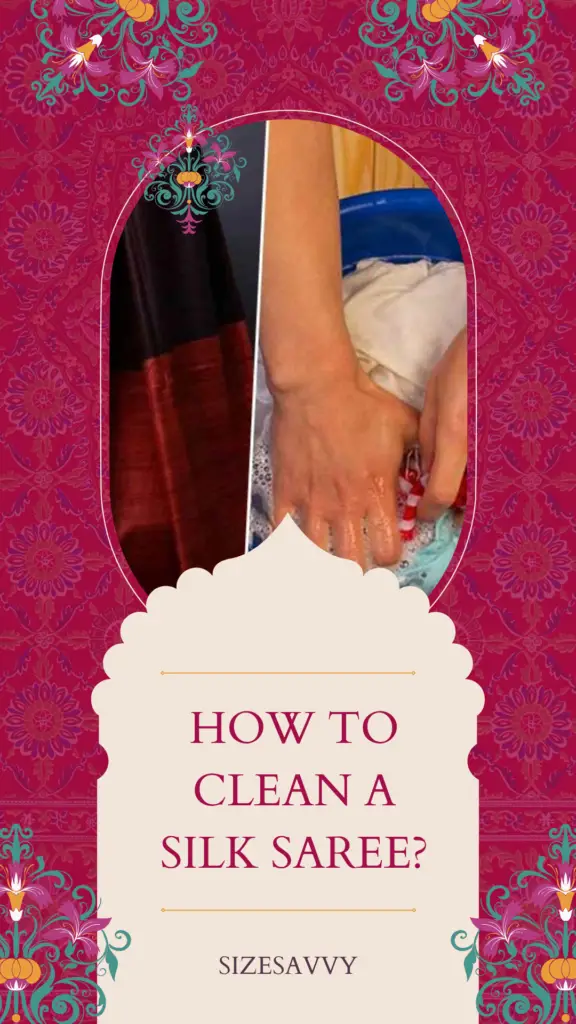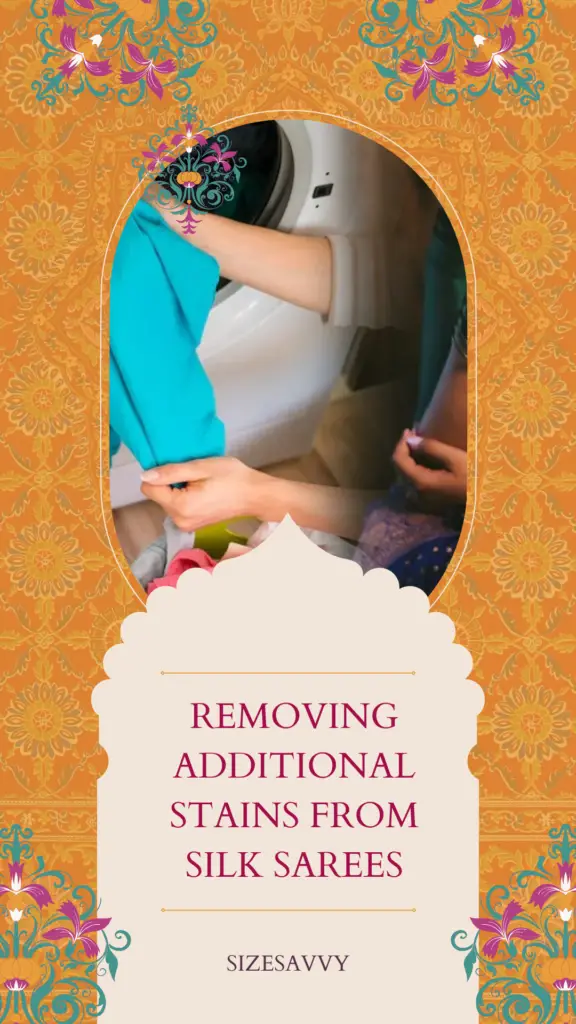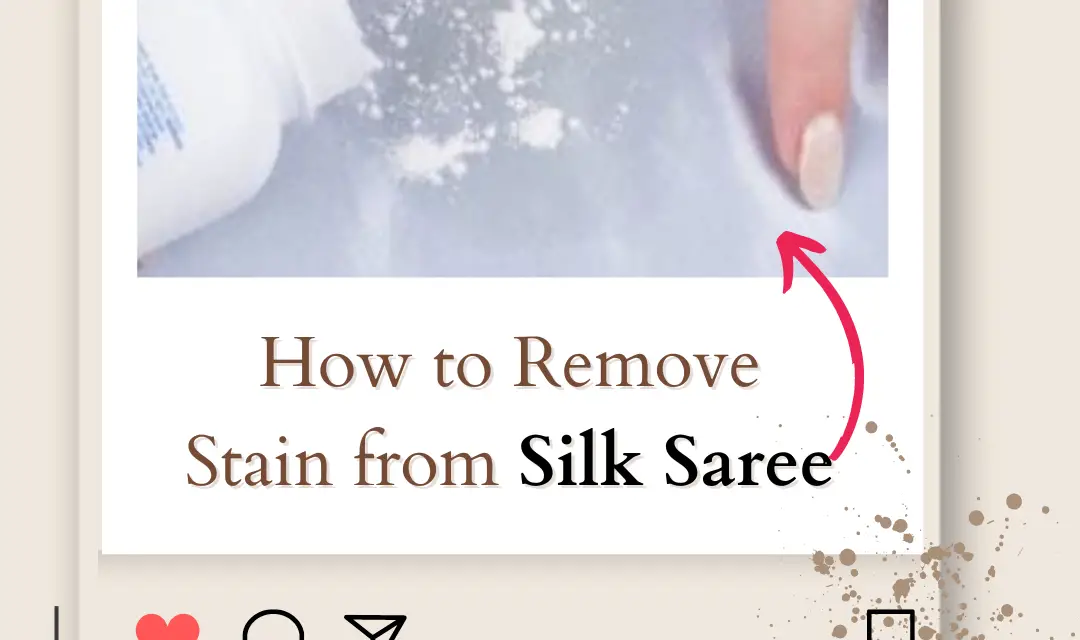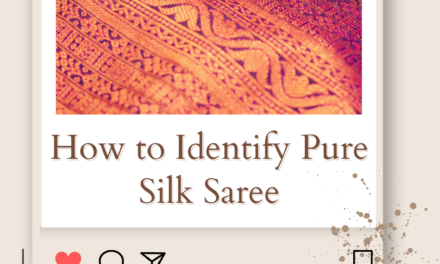How to Remove Stain from Silk Saree? Silk sarees, with their shimmering elegance, are a treasured possession. But accidents happen, and a spill or stain can leave you worried. Fear not! Here’s a guide to removing common stains from your silk saree, ensuring its beauty endures.
Remember: Before attempting any stain removal, always test the chosen method on an inconspicuous area of the saree to check for color fastness. Never rub the stain, as this can spread it and damage the delicate fabric.
Instead, gently blot with a clean, white cloth or absorbent paper towel. Work from the outside of the stain inwards to prevent spreading. Note: this guide can be applied to Branded Sarees to all types of sarees.
How to Clean a Silk Saree?

Cleaning a silk saree requires gentle handling. Professional dry-cleaning is often the safest option. If handwashing is necessary, use a mild saree detergent, and lukewarm water, and avoid wringing. Air-dry by laying the saree flat.
Removing Stains from Silk Sarees
| Silk Saree Stain Types | Silk Saree Treatment | Additional Notes |
| Oil or Grease | 1. Blot excess liquid. 2. Apply talcum powder or cornstarch and leave for 15-30 minutes. 3. Gently brush off the powder. | Test on an inconspicuous area first. |
| Water-based (coffee, tea, fruit juice) | 1. Blot excess liquid. 2. Mix equal parts cold water and mild liquid detergent. 3. Dab the stain with the solution using a clean cloth. | Never use hot water. |
| Ink | (Use with extreme caution) 1. Dab the stain with a cotton ball dipped in a small amount of rubbing alcohol. | Test on an inconspicuous area first. This method can be risky for some silks. |
| Blood | 1. Soak the stain in cold salt water for 30 minutes. 2. Gently rinse with cold water. | Never use hot water. |
| Stubborn Stains | Consult a professional dry cleaner specializing in delicate fabrics. | – |
Common Saree Stain Removal:
- Blot excess liquid with a clean, absorbent cloth.
- For oil or grease: Apply a light layer of talcum powder or cornstarch to absorb the oil. Leave for 15-30 minutes, then gently brush it off.
- For water-based stains (coffee, tea, fruit juice): Mix equal parts cold water and mild liquid detergent. Using a clean cloth, dab the stained area with the solution. Avoid hot water as it can set the stain.
Additional Tips:
- Ink stains: With extreme caution, dab the stain with a cotton ball dipped in a small amount of rubbing alcohol. This method can be risky for some delicate silks, so proceed with caution and test beforehand.
- Blood stains: Soak the stained area in cold salt water for 30 minutes, then gently rinse with cold water. Never use hot water for blood stains.
- Stubborn stains: For complex stains, consult a professional dry cleaner specializing in delicate fabrics like silk. They can assess the stain type and employ appropriate cleaning methods for safe removal.
Removing Additional Stains from Silk Sarees

Here are some additional examples of stains and how to potentially remove them from your silk saree, remembering to always test on an inconspicuous area first and avoid rubbing:
| Stain Type | Treatment | Additional Notes |
| Sweat | 1. Mix equal parts white vinegar and water. 2. Dab the stain with the solution using a clean cloth. 3. Rinse with cool water and lay the saree flat to dry. | Do not use this method on silk that is not colorfast. |
| Makeup (foundation, lipstick) | 1. Apply a small amount of petroleum jelly to the stain. 2. Leave for 15-30 minutes. 3. Blot the stain with a clean cloth. 4. Wash the saree according to care instructions. | Test the petroleum jelly on an inconspicuous area first. Do not use this method on water-based makeup. |
| Food dye | 1. Pre-treat the stain with a commercially available stain remover designed for delicates. Follow the product instructions carefully. 2. Wash the saree according to care instructions. | This method may not be effective for all types of food dye. Consider professional cleaning for stubborn stains. |
| Chocolate | 1. Scrape off any excess chocolate. 2. Pre-treat the stain with a gentle laundry detergent. 3. Wash the saree according to care instructions. | Cold water is recommended for chocolate stains. |
Removing Even More Stains from Your Silk Saree

| Stain Type | Treatment | Additional Notes |
| Candle wax | 1. Allow the wax to harden completely. 2. Gently scrape off as much wax as possible with a blunt knife. 3. Place a clean cloth or brown paper bag over the remaining wax and iron on low heat. The wax will melt and transfer to the cloth/paper. Repeat until the wax is gone. | Do not use a hot iron directly on the silk. |
| Deodorant stains | 1. Mix equal parts white vinegar and water. 2. Dab the stain with the solution using a clean cloth. 3. Rinse with cool water and lay the saree flat to dry. | Do not use this method on silk that is not colorfast. Consider using a commercially available stain remover designed for delicates as an alternative. |
| Pet urine | 1. Blot up as much of the liquid as possible with a clean, absorbent cloth. 2. Mix 1 teaspoon of white vinegar with 1 cup of cool water. 3. Dab the stain with the solution using a clean cloth. 4. Rinse with cool water and lay the saree flat to dry. | Never use hot water as it can set the stain. Consider professional cleaning for stubborn pet urine stains. |
| Grass stains | 1. Pre-treat the stain with a commercially available stain remover designed for delicates. Follow the product instructions carefully. 2. Wash the saree according to care instructions, using cold water. | You may need to repeat the pre-treatment and washing process for stubborn grass stains. |
Remember: When in doubt, err on the side of caution. Seeking professional help is always better than risking permanent damage to your cherished silk saree. With these gentle methods and a bit of care, you can keep your silk sarees looking their radiant best for years to come.
FAQs on Silk Saree Stain
Can stains on silk be removed?
“Yes, stains on silk can often be removed, but the method depends on the type of stain and the care instructions for the specific silk fabric. It’s recommended to address stains promptly and follow proper cleaning techniques.”
How to remove stains from Kanchipuram saree?
“To remove stains from a Kanchipuram silk saree, it’s advisable to consult a professional dry cleaner who specializes in silk fabrics. Attempting to remove stains at home may damage the delicate silk fibers.”
Can baking soda remove stains on silk?
“Baking soda can be used to absorb and lift certain types of stains on silk. However, it’s essential to test on a small, inconspicuous area first and consult care instructions. For persistent stains, professional cleaning is recommended.”
What is the best stain remover for silk?
“The best stain remover for silk depends on the type of stain. Gentle options include mild dish soap, baby shampoo, or specialized silk detergents. Always test in an inconspicuous area and follow care instructions.”
How do you clean 100% pure silk?
“Cleaning 100% pure silk should be done with care. Dry cleaning is the safest option. If handwashing, use a mild detergent, and cold water, and avoid agitation. Air-dry by laying the silk flat.”
How do you wash a costly silk saree?
“Washing a costly silk saree should be approached with caution. Preferably, consult a professional dry cleaner experienced in handling delicate fabrics. If handwashing is necessary, follow the care instructions meticulously.”
How to remove stains on the Pattu saree?
“Stain removal from a Pattu silk saree should be entrusted to a professional dry cleaner specializing in silk fabrics. Attempting DIY stain removal may harm the fabric, so it’s best to seek professional expertise.”















